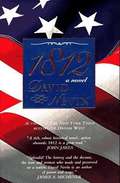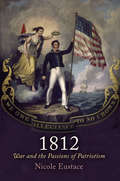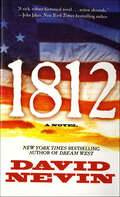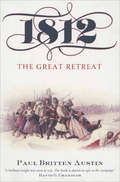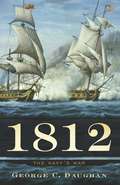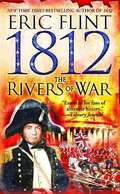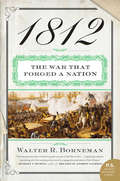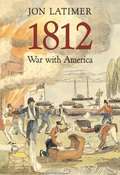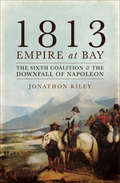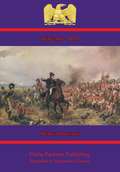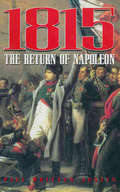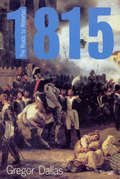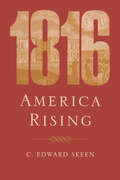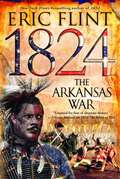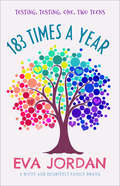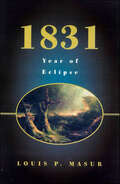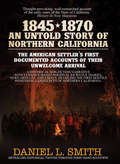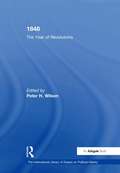- Table View
- List View
1812
by David NevinThe war of 1812 would either make America a global power sweeping all the way to the Pacific--or break it into small pieces bound to mighty England. It was a second revolution of sorts to prove to the British that America had to be taken seriously. The principal actors in this drama were James and Dolley Madison, and Andrew and Rachel Jackson. Their courage and determination would shape America's destiny.
1812
by Nicole EustaceAs military campaigns go, the War of 1812 was a disaster. By the time it ended in 1815, Washington, D.C., had been burned to the ground, the national debt had nearly tripled, and territorial gains were negligible. Yet the war gained so much popular support that it ushered in what is known as the "era of good feelings," a period of relative partisan harmony and strengthened national identity. Historian Nicole Eustace's cultural history of the war tells the story of how an expensive, unproductive campaign won over a young nation--largely by appealing to the heart.1812 looks at the way each major event of the war became an opportunity to capture the American imagination: from the first attempt at invading Canada, intended as the grand opening of the war; to the battle of Lake Erie, where Oliver Perry hoisted the flag famously inscribed with "Don't Give Up the Ship"; to the burning of the Capitol by the British. Presidential speeches and political cartoons, tavern songs and treatises appealed to the emotions, painting war as an adventure that could expand the land and improve opportunities for American families. The general population, mostly shielded from the worst elements of the war, could imagine themselves participants in a great national movement without much sacrifice. Bolstered with compelling images of heroic fighting men and the loyal women who bore children for the nation, war supporters played on romantic notions of familial love to espouse population expansion and territorial aggression while maintaining limitations on citizenship. 1812 demonstrates the significance of this conflict in American history: the war that inspired "The Star-Spangled Banner" laid the groundwork for a patriotism that still reverberates today.
1812: A Novel (The American Story)
by David NevinFrom the New York Times bestselling author David Nevin comes an atonishing historical novel of the War of 1812The war of 1812 would either make America a global power sweeping all the way to the Pacific--or break it into small pieces bound to mighty England. It was a second revolution of sorts to prove to the British that America had to be taken seriously. The principal actors in this drama were James and Dolley Madison, and Andrew and Rachel Jackson. Their courage and determination would shape America's destiny.At the Publisher's request, this title is being sold without Digital Rights Management Software (DRM) applied.
1812: The Great Retreat
by Paul Britten Austin1812: The Great Retreat the third and final volume in Austins magisterial trilogy concludes the story of one of history's most disastrous campaigns. The author's previous books brought the Grand Army to the head-on battle at Malo-Jaroslavetz after withdrawing sixty miles from the burnt down capital, and for the first time in his meteoric career Napoleon had to order a retreat. This volume follows the army's withdrawal through 800 miles of devastated countryside, crossing the horrific relics of the Borodino battlefield, fighting its way through the Russian General Kutusov's successive attempts to cut it off, and winning, against overwhelming odds, the three-day battle of the Berezina crossing. First-hand narratives, many published in English for the first time, describe Marshal Ney's astounding achievement in holding together the rear-guard until he himself, musket in hand, was the last man to re-cross the Niemen into Poland.Using the words of the participants themselves, Paul Britten Austin brings unparalleled authenticity and immediacy to his unique account of the closing stages of Napoleon's dramatic and tragic 1812 campaign.
1812: The March On Moscow
by Paul Britten AustinThis account of Napoleon&’s disastrous invasion of Russia, in the words of those who experienced it, offers &“a brilliant insight into men at war&” (David G. Chandler, author of The Campaigns of Napoleon). Hundreds of thousands of men set out on that midsummer day of 1812. None could have imagined the terrors and hardships to come. They&’d been lured all the way to Moscow without having achieved the decisive battle Napoleon sought—and by the time they reached the city, their numbers had already dwindled by more than a third. One of the greatest disasters in military history was in the making. The fruit of more than twenty years of research, this superbly crafted work skillfully blends the memoirs and diaries of more than a hundred eyewitnesses, all of whom took part in the Grand Army&’s doomed march on Moscow, to reveal the inside story of this landmark military campaign. The result is a uniquely authentic account in which the reader sees and experiences the campaign through the eyes of participants in enthralling day-by-day, sometimes hour-by-hour detail.
1812: The Navy's War
by George C. DaughanAt the outbreak of the War of 1812, America’s prospects looked dismal. It was clear that the primary battlefield would be the open ocean-but America’s war fleet, only twenty ships strong, faced a practiced British navy of more than a thousand men-of-war. Still, through a combination of nautical deftness and sheer bravado, the American navy managed to take the fight to the British and turn the tide of the war: on the Great Lakes, in the Atlantic, and even in the eastern Pacific. In 1812: The Navy’s War, prizewinning historian George C. Daughan tells the thrilling story of how a handful of heroic captains and their stalwart crews overcame spectacular odds to lead the country to victory against the world’s greatest imperial power. A stunning contribution to military and national history, 1812: The Navy’s War is the first complete account in more than a century of how the U. S. Navy rescued the fledgling nation and secured America’s future.
1812: The Rivers of War
by Eric FlintEric Flint's acclaimed 1634: The Galileo Affair was a national bestseller from one of the most talked-about voices in his field. Now, in this extraordinary new alternate history, Flint begins a dramatic saga of the North American continent at a dire turning point, forging its identity and its future in the face of revolt from within, and attack from without. In the War of 1812, U. S. troops are battling the British on the Canadian border, even as a fierce fight is being waged against the Creek followers of the Indian leader Tecumseh and his brother, known as The Prophet. In Europe, Napoleon Bonaparte's war has become a losing proposition, and the British are only months away from unleashing a frightening assault on Washington itself. Fateful choices are being made in the corridors of power and on the American frontier. As Andrew Jackson, backed by Cherokee warriors, leads a fierce attack on the Creek tribes, his young republic will soon need every citizen soldier it can find. What if-at this critical moment-bonds were forged between men of different races and tribes? What if the Cherokee clans were able to muster an integrated front, and the U. S. government faced a united Indian nation bolstered by escaping slaves, freed men of color, and even influential white allies? Through the remarkable adventures of men who were really there-men of mixed race, mixed emotions, and a singular purpose-The Rivers of War carries us in this new direction, brilliantly transforming an extraordinary chapter of American history. With a cast of unforgettable characters-from James Monroe and James Madison to Sam Houston, Francis Scott Key, and Cherokee chiefs John Ross and Major Ridge-The Rivers of War travels from the battle of Horseshoe Bend to the battle of New Orleans, and brings every explosive moment to life. With exquisite attention to detail, an extraordinary grasp of history, and a storyteller's gift for the dramatic, Flint delivers a bold, thought-provoking epic of enemies and allies, traitors and revolutionaries, and illuminates who we are as a nation, how we got here, and how history itself is made-and remade.
1812: The War of 1812 (P. S. Series)
by Walter R. BornemanIn June 1812 the still-infant United States had the audacity to declare war on the British Empire. Fought between creaking sailing ships and armies often led by bumbling generals, the ensuing conflict featured a tit-for-tat "You burned our capital, so we'll burn yours" and a legendary battle unknowingly fought after the signing of a peace treaty. During the course of the war, the young American navy proved its mettle as the USS Constitution, "Old Ironsides," sent two first-rate British frigates to the bottom, and a twenty-seven-year-old lieutenant named Oliver Hazard Perry hoisted a flag exhorting, "Don't Give Up the Ship," and chased the British from Lake Erie. By 1814, however, the United States was no longer fighting for free trade, sailors' rights, and as much of Canada as it could grab, but for its very existence as a nation. With Washington in flames, only a valiant defense at Fort McHenry saved Baltimore from a similar fate. Here are the stories of commanding generals such as America's Henry "Granny" Dearborn, double-dealing James Wilkinson, and feisty Andrew Jackson, as well as Great Britain's gallant Sir Isaac Brock, overly cautious Sir George Prevost, and Rear Admiral George Cockburn, the man who put the torch to Washington. Here too are those inadvertently caught up in the war, from heroine farm wife Laura Secord, whom some call Canada's Paul Revere, to country doctor William Beanes, whose capture set the stage for Francis Scott Key to write "The Star-Spangled Banner." 1812: The War That Forged a Nation presents a sweeping narrative that emphasizes the struggle's importance to America's coming-of-age as a nation. Though frequently overlooked between the American Revolution and the Civil War, the War of 1812 did indeed span half a continent -- from Mackinac Island to New Orleans, and Lake Champlain to Horseshoe Bend -- and it paved the way for the conquest of the other half. During the War of 1812, the United States cast aside its cloak of colonial adolescence and -- with both humiliating and glorious moments -- found the fire that was to forge a nation.
1812: War with America
by Jon LatimerThe British viewed the War of 1812 as an ill-fated attempt by the young American republic to annex Canada. For British Canada, populated by many loyalists who had fled the American Revolution, this was a war for survival. The Americans aimed both to assert their nationhood on the global stage and to expand their territory northward and westward. Americans would later find in this war many iconic moments in their national story--the bombardment of Fort McHenry (the inspiration for Francis Scott Key's "Star Spangled Banner"); the Battle of Lake Erie; the burning of Washington; the death of Tecumseh; Andrew Jackson's victory at New Orleans--but their war of conquest was ultimately a failure. Even the issues of neutrality and impressment that had triggered the war were not resolved in the peace treaty. For Britain, the war was subsumed under a long conflict to stop Napoleon and to preserve the empire. The one lasting result of the war was in Canada, where the British victory eliminated the threat of American conquest, and set Canadians on the road toward confederation. Latimer describes events not merely through the eyes of generals, admirals, and politicians but through those of the soldiers, sailors, and ordinary people who were directly affected. Drawing on personal letters, diaries, and memoirs, he crafts an intimate narrative that marches the reader into the heat of battle.
1813: The Sixth Coalition & the Downfall of Napoleon
by Jonathon RileyA distinguished historian and British Army veteran examines the political and military alliances that led to the defeat of France in the Napoleonic Wars. 1813 was a critical year in the war that ended with the downfall of Napoleon—the year in which the balance of power tipped decisively against the French monarch&’s First Empire. In 1813: Empire at Bay, military historian and retired British Army Lt. Gen. Jonathon Riley explores the international alliance behind the major campaigns that raged across Europe and ultimately broke France&’s power. Focusing on the nations of the Sixth Coalition—Austria, Prussia, Russia, the United Kingdom, Portugal, Sweden, Spain, and the smaller German states—Riley reveals how this unprecedented alliance became the prototype of all uneasy modern coalitions. Despite their common enemy and shared goals, the international leaders and military officers had to navigate troubled command relationships, disagreements on strategy and operations, and clashing political ambitions. Riley also reassesses Napoleon&’s strengths and faults as an alliance commander, overseeing armies of not only Frenchmen but also Poles, Danes, Italians, Germans, and a host of other contingents. In vivid detail, Riley&’s groundbreaking book covers the battles of Lützen, Bautzen, Dresden, and Leipzig, demonstrating how they were each in their own way a decisive step toward Napoleon&’s defeat at Waterloo.
1815 — Waterloo [Illustrated Edition]
by Henry Houssaye S. R. WillisThis ebook is purpose built and is proof-read and re-type set from the original to provide an outstanding experience of reflowing text for an ebook reader. Waterloo Illustration Pack - 14 maps/battle plans, 18 portraits of the personalities engaged, 10 illustrations. Houssaye's history of the 1815 campaign stands out as perhaps the most complete and least biased French account of the campaign that culminated in the downfall of Napoleon. Filled with detail from numerous French sources and written in a light style, it provides a complete look at the campaign whilst keeping the narrative to a reasonable length. There is also an occasional flash of wit - usually missing from French accounts, substituted instead with accusation and counter accusation - which makes the book a real joy to read. For example, speaking of Grouchy on the morning of the 18th "Grouchy was eating some strawberries (to eat strawberries is not, moreover, a hanging matter, even on a morning of battle),..." Henry Houssaye, an esteemed member of the French Institute, wrote a number of works on the Napoleonic period (mainly of the later years of Napoleon), amongst them plays and ancient history. Title - 1815 -- Waterloo Author -- Henry Houssaye (1848-1911) Translation -- S. R. Willis (????-????) Text taken, whole and complete, from the edition published in 1905, Kansas, by Franklin Hudson Publishing Co. Original - 268 pages. Illustrations - The original map cannot be provided with this edition due to its A3 size - We have added our Waterloo Illustration pack to ensure that the reader can follow the text.
1815: The Return of Napoleon (The\napoleonic Library)
by Paul Britten AustinThe dramatic story of Napoleon&’s escape from Elba and march on Paris—in the words of eyewitnesses and participants. Drawing on hundreds of firsthand accounts by Napoleon&’s supporters and opponents, Paul Britten Austin recreates the drama of those tumultuous days of the spring of 1815 and throws light on the mixed French response to the unexpected return of their former emperor. 1815: The Return of Napoleon recreates, in the words of those present, Napoleon&’s dramatic landing at Antibes in the south of France; the first heady days of his arrival after almost a year of exile; his almost miraculous march across France; his arrival in Paris; and the coup which led to the fall of the Bourbons. Paul Britten Austin, author of an acclaimed trilogy on Napoleon&’s invasion of Russia, brings historical events to life and gives a dramatic insight into the hopes and fears of the French nation in that spring of 1815.
1815: The Roads to Waterloo
by Gregor DallasThe seventeen months from April 1814 to August 1815 were an extraordinary period in European history; a period which saw two sieges of Paris, a complete revision of Europe's political frontiers, an international Congress set up in Vienna, civil war in Italy and international war in Belgium.Gregor Dallas tells the story of these days through the perspectives of three very different European cities: the great metropolis of London, post-revolutionary Paris and baroque Vienna. The writing is almost cinematic in its power to evoke and bring to life the Europe of Tolstoy: the ebb and flow of power, of armies and of peoples across Europe's northern plains. Working essentially from primary sources, Dallas is as interested in the weather conditions before battle as in the way cartoonists reacted to court intrigues and fashions.It is also Europe seen through the eyes of its central players: Talleyrand, who has served nearly every French regime since the Revolution of 1789; Metternich, who devises new plans for a 'Germany' that does not yet exist and for a 'Europe' that remains devided; Wellington, who reveals himself a diplomat as well as a soldier; Tsar Alexander, an idealist seeking to impose a uniform plan for all Europe; and 'Boney' himself, who has his own ideal of Europe and, though banished to Elba, does not abandon his dream to realise it.
1816: America Rising
by C. Edward Skeen“Makes the case for 1816 as an important year in the development of the American nation. Well-written and -researched . . . recommended.”—Library JournalThe year 1816 found America on the cusp of political, social, cultural, and economic modernity. Celebrating its fortieth year of independence, the country’s sense of self was maturing. Americans, who had emerged from the War of 1812 with their political systems intact, embraced new opportunities. For the first time, citizens viewed themselves not as members of a loose coalition of states but as part of a larger union. This optimism was colored, however, by bizarre weather. Periods of extreme cold and severe drought swept the northern states and the upper south throughout 1816, which was sometimes referred to as “The Year Without a Summer.” In 1816 , historian C. Edward Skeen illuminates this unique year of national transition. Politically, the “era of good feelings” allowed Congress to devise programs that fostered prosperity. Social reform movements flourished. This election year found the Federalist party in its death throes, seeking cooperation with the nationalistic forces of the Republican party. Movement west, maturation of political parties, and increasingly contentious debates over slavery characterized this pivotal year. 1816 marked a watershed in American history. This provocative book vividly highlights the stresses that threatened to pull the nation apart and the bonds that ultimately held it together.“Reveals a sense of the fragility of the American experiment.” —Boston Globe“Skeen narrates the major events of [the era’s] opening 12 months with great skill . . . with clarity and verve.” —Publisher’s Weekly“A very impressive exposition of political culture in the early republic.” —Andrew Burstein, author of Jefferson’s Secrets
1824: The Arkansas War
by Eric FlintIn the newest volume of this exhilarating series, Eric Flint continues to reshape American history, imagining how a continent and its people might have taken a different path to its future. With 1824: The Arkansas War, he spins an astounding and provocative saga of heroism, battlefield action, racial conflict, and rebellion as a nation recovering from war is plunged into a dangerous era of secession. Buffered by Spanish possessions to the south and by free states and two rivers to the north, Arkansas has become a country of its own: a hybrid confederation of former slaves, Native American Cherokee and Creek clans, and white abolitionists-including one charismatic warrior who has gone from American hero to bête noire. Irish-born Patrick Driscol is building a fortune and a powerful army in the Arkansas Confederacy, inflaming pro-slavers in Washington and terrifying moderates as well. Caught in the middle is President James Monroe, the gentlemanly Virginian entering his final year in office with a demagogic House Speaker, Henry Clay, nipping at his heels and fanning the fires of war. But Driscol, whose black artillerymen smashed both the Louisiana militia in 1820 and the British in New Orleans, remains a magnet for revolution. And fault lines are erupting throughout the young republic-so that every state, every elected official, and every citizen will soon be forced to choose a side. For a country whose lifeblood is infected with the slave trade, the war of 1824 will be a bloody crisis of conscience, politics, economics, and military maneuvering that will draw in players from as far away as England. For such men as Secretary of State John Quincy Adams, Commissioner of Indian Affairs Sam Houston, charismatic war hero Andrew Jackson, and the violent abolitionist John Brown, it is a time to change history itself. Filled with fascinating insights into some of America's most intriguing historical figures, 1824: The Arkansas War confirms Eric Flint as a true master of alternate history, a novelist who brings to bear exhaustive research, remarkable intuition, and a great storyteller's natural gifts to chronicle the making of our nation as it might have been. From the Hardcover edition.
183 Times a Year: A Witty and Heartfelt Family Drama (The Tree of Family Life Trilogy #1)
by Eva Jordan“A candid account of family life that we can all relate to . . . An absolutely astonishing, thought provoking, hilarious and life affirming debut novel.” —The Book MagnetMeet Lizzie, the exasperated mother of Cassie, Connor, and stepdaughter Maisy. She gets by with good friends, cheap wine and talking to herself.Teenager Cassie, the Facebook-tweeting, selfie-taking, music and mobile phone-obsessed daughter, hates everything about her life. She longs for a different existence and wishes her parents had never divorced.However, the discovery of a terrible betrayal, and a brutal attack, throws the whole household into disarray. Lizzie and Cassie are forced to reassess the important things in life as they embark upon separate journeys of self-discovery . . .Although tragic at times this is a delightfully funny exploration of domestic love, hate, strength and ultimately friendship. A poignant, heartfelt look at that complex and diverse relationship between a mother and daughter set amongst the thorny realities of today’s divided and extended families.Mothers and daughters alike will never look at each other in quite the same way after reading this book—a brilliantly funny observation of contemporary family life.“An emotional roller-coaster of a ride that details family life . . . [a] beautifully written debut novel from Eva Jordan that should appeal to men not just women. There are some very emotive comments contained within the story many will ring true for every reader. A highly enjoyable read.” —The Last Word Book ReviewDon’t miss books two and three in the trilogy: All the Colours in Between and Time Will Tell
1831: Year of Eclipse
by Louis P. Masur1776, 1861, 1929. Any high-school student should know what these years meant to American history. But wars and economic disasters are not our only pivotal events, and other years have, in a quieter way, swayed the course of our nation. 1831 was one of them, and in this striking new work, Louis Masur shows us exactly how.The year began with a solar eclipse, for many an omen of mighty changes -- and for once, such predictions held true. Nat Turner's rebellion soon followed, then ever-more violent congressional arguments over slavery and tarrifs. Religious revivalism swept the North, and important observers (including Tocqueville) traveled the land, forming the opinions that would shape the world's view of America for generations to come. New technologies, meanwhile, were dramatically changing Americans' relationship with the land, and Andrew Jackson's harsh policies toward the Cherokee erased most Indians' last hopes of autonomy. As Masur's analysis makes clear, by 1831 it was becoming all too certain that political rancor, the struggle over slavery, the pursuit of individualism, and technological development might eclipse the glorious potential of the early republic--and lead the nation to secession and civil war. This is an innovative and challenging interpretation of a key moment in antibellum America.
1844: My Year of Change (Into Reading, Level M #76)
by Susy Boyer Peter MillettNIMAC-sourced textbook
1845-1870 An Untold Story of Northern California: The American Settler's First Documented Accounts of their Unwelcome Arrival
by Daniel Smith1845-1870 An Untold Story of Northern California is a revisionist historical non-fiction narrative of the American settling of Northern California, and their difficult experiences with local native conflicts that arose. These hostility's have been eyeballed and extensively written about through the eyes of the indigenous locals. Modern knowledge on the true experiences of the pioneers settling of this specific area of 19th century Northern California, today, is seemingly swept under the rug. This literature serves as a window for the reader to understand the mindsets and culture of the American settlers as they homesteaded the Northern California region from 1845 to 1870. This literature includes massive amounts of information regarding unheard-of regional hostilities and depredations against the American settlers during this time-frame. 1845-1870 An Untold Story of Northern California also exposes and ties-in certain cultural. religious, and legal functions that solidified the history of what truly happened during Northern California's unstable history! A must-have for students, teachers, and history enthusiasts!
1848: The Year of Revolutions (The International Library of Essays on Political History)
by Peter H. WilsonEurope was swept by a wave of revolution in 1848 that had repercussions stretching well beyond the Continent. Governments fell in quick succession or conceded significant reforms, before being rolled back by conservative reaction. Though widely perceived as a failure, the revolution ended the vestiges of feudalism, broadened civil society and strengthened the state prior to the rapid industrialisation and urbanisation of the latter part of the nineteenth century. This volume brings together essays from leading specialists on the international dimension, national experiences, political mobilisation, reaction and legacy.
1848: Year Of Revolution
by x Mike RapportIn 1848, Europe was engulfed in a firestorm of revolution. The streets of cities from Paris to Bucharest and from Berlin to Palermo were barricaded and flooded by armed insurgents proclaiming political liberties and national freedom. The conservative order which had held sway since the fall of Napoleon in 1815 crumbled beneath the revolutionary assault. This book narrates the breathtaking events which overtook Europe in 1848, tracing brilliantly their course from the exhilaration of the liberal triumph, through the fear of social chaos to the final despair of defeat and disillusionment. The failures of 1848 would scar European history with the contradictions of authoritarianism and revolution until deep into the twentieth century.

